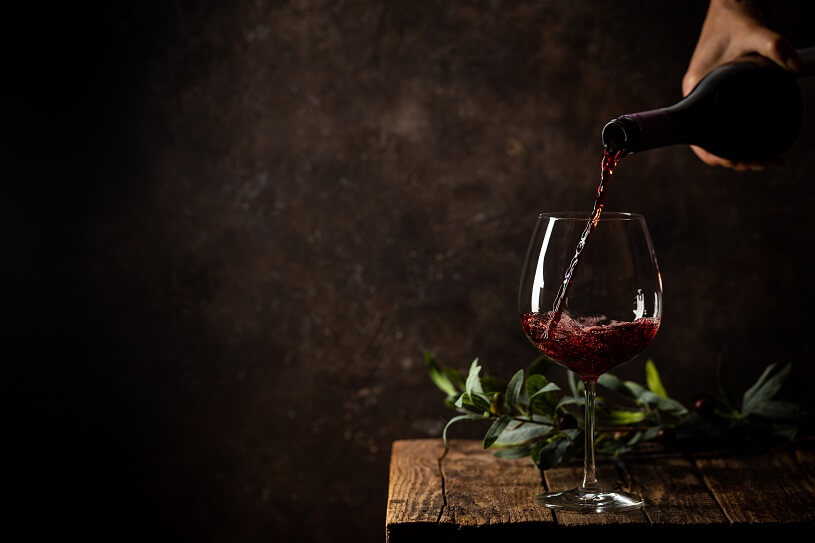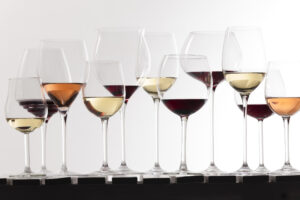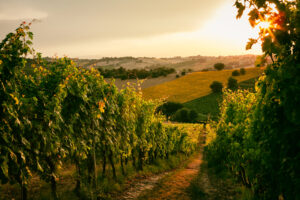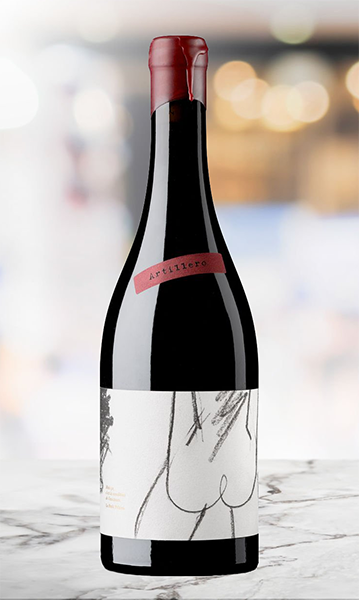- Posted on
- By Cellars Wine Club
- In Wine Life Blog

Wine blending is pure art. An age-old winemaking method that has been on track for hundreds of years allows winemakers to fine-tune characteristics and create complex symphonies of flavor, with each grape offering its special features.
The technique requires a deep knowledge of winemaking principles as well as the qualities of grapes to successfully balance out the flavor characteristics and create a harmonious whole.
Both white and red wine blends are extremely well-liked among real wine admirers. They let wine aficionados estimate the whole profusion of flavor and appreciate the mind-blowing symbiosis of fruit, texture, and mouthfeel.
Check out the eight famous wine blends for the finest drink experience, and choose your favorites!
Champagne

We bet you didn’t expect to find out that this quintessential French wine is, actually, a blend.
Champagne, which showcases its signature style, is made from a combination of the three dominant grape varieties of the Champagne region – Pinot Noir, Pinot Meunier, and Chardonnay.
Pinot Noir is considered the heart of Champagne blend, giving it body, structure, strength, and grip. There are nearly 40% of the Pinot Noir plantings across the Champagne region.
A full-bodied white wine, Chardonnay, is perfect for aging. Its floral and mineral notes offer exceptional finesse in the mouth. The wines are characterized by delicate aromas with floral, citrus, and mineral notes. There are 30% of the Chardonnay plantings on the Champagne lands.
The final component, Pinot Meunier, takes nearly 35% of the Champagne plantings. Its soft and fruity notes make an ideal blending with the more assertive flavors of Pinot Noir. Together they create an intense bouquet.
Champagne wines range from sweet to very dry due to the immense variety of the climate and soil in the region. Thus the grapes end up making a diverse range of Champagne wines.
A versatile and food-friendly wine, Champagne can pair well with almost anything. Depending on its style and sweetness level, the best food pairings for Champagne blend wines are seafood, fish, meat and poultry, deep-fried food, cheeses, and fruits.
Red Bordeaux
The unsurpassed Bordeaux is next on our list of popular wine blends. Both the white and red wines use two or more grapes. The classic varieties in a Bordeaux red blend include Cabernet Sauvignon, Cabernet Franc, Petit Verdot, Merlot, and Malbec. A red wine grape variety, Carmenère, appears rarely.
Though having several blends, around 90% of Bordeaux wines are red, made with Merlot and Cabernet Sauvignon. The combination of the complex and tannic Cabernet Sauvignon with a ripe, sensual-textured, and velvety Merlot makes a perfect balance of flavors that guarantees the finest drink experience.
The flavor of the red Bordeaux will depend on quality, vintage, and where exactly in Bordeaux the grapes were grown. In order for you to understand the scope, the whole region is divided into two areas: the Bordeaux Right Bank and the Bordeaux Left Bank, where there are 57 subregions altogether. Wine regions are vital in specifying the flavor.
The red blend ranges from medium- to full-bodied wines with black currant and plum aromas. While drinking, you will notice fruity flavors and earthy notes, and, of course, the picky, mouth-drying tannins.
Creamy blue cheeses or brie will intensify your drinking experience. Also, you will never go wrong with classic pairings like beef-based dishes, roast lamb, venison, or duck breast.
Red Meritage

A well-known red wine blend, Meritage, is made from two or more blends of the following red “noble” grape varieties: Cabernet Sauvignon, Merlot, Cabernet Franc, Carmenère, St. Macaire, Gros Verdot, Petit Verdot, or Malbec.
A full-bodied red wine, Cabernet Sauvignon, typically provides the basic structure for Meritage. A rich, violet-scented bouquet and spicy flavors are what Cabernet Franc delivers. Petit Verdot is responsible for color, tannin, and depth. Merlot rounds and softens the red wine blend.
Meritage blends are made in the same spirit and by using the same grapes as the Bordeaux blends. What’s interesting, neither the grapes nor the wine is from Bordeaux. Red wine grapes are grown in the United States, particularly in the state of California.
Meritage wine is among the most highly rated due to its complex notes and silky smooth texture. Black currants are the predominant flavor, with notes of sweet tobacco, cedar, and leather from the French oak barrels used for aging. A smoothness and harmony of flavors are exactly what the wine offers.
The best food pairings include cheeses, especially mild and medium sharp Cheddar, Parmesan, Edam, Gloucester, and Corvo; meat and poultry; cheese-based pasta with mushrooms, and risotto.
Côtes du Rhône
Côtes du Rhône, a geographical grape-growing region in France’s Rhône Valley, is well-known for its blending mastery.
The classic Côtes du Rhône wine is usually moderate in color and tannin but also high in alcohol. It is robust without being overpowering.
The most favored blend is a red combination of Grenache, Syrah, and Mourvedre grapes, making an abbreviation “G-S-M.” The trinity truly defines the red blend wine style.
Grenache is usually the largest percentage of a G-S-M wine blend. You will notice it with the distinctive raspberry and strawberry flavors peppered with spice. Syrah is responsible for acidity, structure, and spicy, peppery notes, while Mourvèdre brings a deep hue, tannins, and flavors of red fruit, dark berries, and game.
Côtes du Rhône wines pair beautifully with grilled or roasted vegetables, chicken, salmon, or pork.
Port

A classic dessert wine from Portugal’s Douro Valley, Port, is in the ranks of the most popular red blend wines in the world.
The grape varieties include Touriga Franca, Tinta Barroca, Touriga Nacional, Tinto Cão, and many others. Each grape brings a unique note, which ultimately results in a redolent blend with the warm, fruity, rich flavor characteristics of Port.
It’s impossible to confuse a perfumed, spicy, rich, and fruity Port with any other wine. Its black fruit, cinnamon, clove, caramel, chocolate, and violet notes can’t leave anyone indifferent.
Savory and sweet foods are the best Port matches. It goes great with chocolate, nuts, charcuterie boards, cheeses, olives, plums, and dates. Such main dishes as meat, sushi, and surf & turf also make perfect food pairings with Portuguese wine.
Chianti
Few wine lovers know that Chianti is a blend. Plenty of people suppose Sangiovese is the hero of the story. An interesting fact is that 100% Sangiovese wine was once forbidden by Consorzio’s laws. So, what’s in a blend?
Chianti Classico contains at least 80% Sangiovese. Another 20% of the red grapes include Cabernet Sauvignon, Colorino, Merlot, or Canaiolo Nero.
Sangiovese’s tart red cherry flavors, mouth-watering acidity, and sandy tannins make Chianti a true masterpiece in the wine world. Merlot, Cabernet, and Canaiolo play the roles of “softeners” of Sangiovese’s tannins. They also add fruity notes and cherry flavors. Colorino is responsible for structure and color.
Though the wine is not as smooth as some other reds, that exceptional tartness and slight roughness give Chianti so much charm!
This Italian wine is extremely food-friendly. It goes well with meaty Italian dishes, including true Italian pizzas, Chicken Parmesan, bruschetta, snacks, and platters.
Rioja

One more renowned Spanish wine, born in the Rioja region, hits the shelves with its high quality and wonderful flavors.
Rioja is known for its mind-blowing variety of styles. The winemaking area, divided into three zones: Rioja Alta, Rioja Alavesa, and Rioja Orienta, stretches 75 miles from northwest to southeast. This results in diverse climates, topography, and soil types, consequently influencing the quality and wine style.
The red wine blend comprises 70% Tempranillo grapes, which have been cultivated in Spain for over 2,000 years. Being at the heart of Rioja’s best wines, Tempranillo makes them abundantly fruity and light. Rioja also contains Mazuelo, which gives tannin and color; Graciano, prized for its aroma and acidity; and Maturana Tinta grapes, used to complement the final blend.
Due to oak aging, introduced as early as the 18th century, the Rioja wines have a distinct vanilla flavor. Usually, it takes 4-8 years for top red reserve wines to age.
Rioja wines offer a contemporary fruit palate. Cherry, plum, dill, vanilla, and leather notes make them graceful, silky, and perfumed.
Rioja tastes great with almost anything. If you’ve grabbed a bottle of a younger wine, go for savory meats and strong cheeses. Also, pair the drink with Jamon Serrano and a bowl of ripe green olives to feel the vibes of picturesque Spain.
Priorat
The Spanish regional wine blend from a small wine region, Priorat, closes our list. The rugged, robust, and powerful blend has already conquered the hearts of many wine lovers.
Red grape varieties include Grenache, Syrah, Merlot, Cabernet Sauvignon, and Carignan. Grenache adds the red blend body and density. Cabernet Sauvignon, which rarely contributes more than 20% of the blend, is responsible for the structure. Merlot adds a certain roundness. Carignan brings depth, intensity, and fruit flavors. Syrah adds earthiness.
All in all, we have a dry red blend, high in both alcohol and tannins, with a thick texture. If you are a fan of fruity wines, then Priorat will be a great choice. High-quality Priorat red wines feature a prominent aroma profile that includes black and red plum, currant, and black cherry. They also should have that wonderful streak of petrichor minerality.
Perfect food pairings for Priorat include roasted vegetables, game, pepper stews, and sausages. Dishes with a generous amount of spice and pepper also go well with Priorat wines.
The Bottom Line
As we’ve already mentioned, wine blending is pure art. It’s definitely the most creative part of being a winemaker, as you get a chance to hone your skills at flavor balancing.
Unlike single-varietal wines with a very particular taste profile and clear tasting notes, wine blends are typically more rounded due to the combination of different flavors and aromas from the various berries mixed in there.
Hope you enjoyed our list of eight amazing wine blends for the finest drink experience. From good old French classics like Bordeaux to the relatively new Meritage of the New World, the intriguing wines with flavor qualities that are unlike anything else on the market won’t leave anyone indifferent.
So, have you already picked your favorite wine blends?









